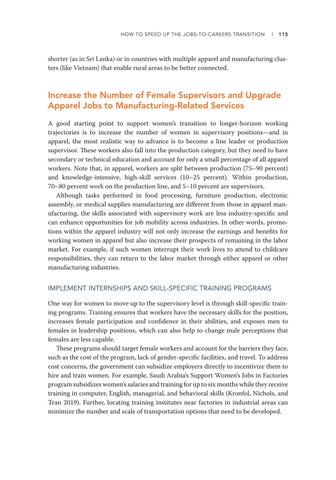How to Speed Up the Jobs-to-Careers Transition
l
115
shorter (as in Sri Lanka) or in countries with multiple apparel and manufacturing clusters (like Vietnam) that enable rural areas to be better connected.
Increase the Number of Female Supervisors and Upgrade Apparel Jobs to Manufacturing-Related Services A good starting point to support women’s transition to longer-horizon working trajectories is to increase the number of women in supervisory positions—and in apparel, the most realistic way to advance is to become a line leader or production supervisor. These workers also fall into the production category, but they need to have secondary or technical education and account for only a small percentage of all apparel workers. Note that, in apparel, workers are split between production (75–90 percent) and knowledge-intensive, high-skill services (10–25 percent). Within production, 70–80 percent work on the production line, and 5–10 percent are supervisors. Although tasks performed in food processing, furniture production, electronic assembly, or medical supplies manufacturing are different from those in apparel manufacturing, the skills associated with supervisory work are less industry-specific and can enhance opportunities for job mobility across industries. In other words, promotions within the apparel industry will not only increase the earnings and benefits for working women in apparel but also increase their prospects of remaining in the labor market. For example, if such women interrupt their work lives to attend to childcare responsibilities, they can return to the labor market through either apparel or other manufacturing industries. IMPLEMENT INTERNSHIPS AND SKILL-SPECIFIC TRAINING PROGRAMS One way for women to move up to the supervisory level is through skill-specific training programs. Training ensures that workers have the necessary skills for the position, increases female participation and confidence in their abilities, and exposes men to females in leadership positions, which can also help to change male perceptions that females are less capable. These programs should target female workers and account for the barriers they face, such as the cost of the program, lack of gender-specific facilities, and travel. To address cost concerns, the government can subsidize employers directly to incentivize them to hire and train women. For example, Saudi Arabia’s Support Women’s Jobs in Factories program subsidizes women’s salaries and training for up to six months while they receive training in computer, English, managerial, and behavioral skills (Kronfol, Nichols, and Tran 2019). Further, locating training institutes near factories in industrial areas can minimize the number and scale of transportation options that need to be developed.


